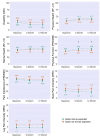Patient-Centered Goals After Lumbar Spine Surgery: A Secondary Analysis of Cognitive-Behavioral-Based Physical Therapy Outcomes From a Randomized Controlled Trial
- PMID: 35778941
- PMCID: PMC10071580
- DOI: 10.1093/ptj/pzac091
Patient-Centered Goals After Lumbar Spine Surgery: A Secondary Analysis of Cognitive-Behavioral-Based Physical Therapy Outcomes From a Randomized Controlled Trial
Abstract
Objective: The purpose of this study was to examine the association between goal attainment and patient-reported outcomes in patients who engaged in a 6-session, telephone-based, cognitive-behavioral-based physical therapy (CBPT) intervention after spine surgery.
Methods: In this secondary analysis of a randomized trial, data from 112 participants (mean age = 63.3 [SD = 11.2] years; 57 [51%] women) who attended at least 2 CBPT sessions (median = 6 [range = 2-6]) were examined. At each session, participants set weekly goals and used goal attainment scaling (GAS) to report goal attainment from the previous session. The number and type of goals and percentage of goals met were tracked. An individual GAS t score was computed across sessions. Participants were categorized based on goals met as expected (GAS t score ≥ 50) or goals not met as expected (GAS t score < 50). Six- and 12-month outcomes included disability (Oswestry Disability Index), physical and mental health (12-Item Short-Form Health Survey), physical function (Patient-Reported Outcomes Measurement Information System), pain interference (Patient-Reported Outcomes Measurement Information System), and back and leg pain intensity (numeric rating scale). Outcome differences over time between groups were examined with mixed-effects regression.
Results: Participants set a median of 3 goals (range = 1-6) at each session. The most common goal categories were recreational/physical activity (36%), adopting a CBPT strategy (28%), exercising (11%), and performing activities of daily living (11%). Forty-eight participants (43%) met their goals as expected. Participants who met their goals as expected had greater physical function improvement at 6 months (estimate = 3.7; 95% CI = 1.0 to 6.5) and 12 months (estimate = 2.8; 95% CI = 0.04 to 5.6). No other outcome differences were noted.
Conclusions: Goal attainment within a CBPT program was associated with 6- and 12-month improvements in postoperative physical functioning.
Impact: This study highlights goal attainment as an important rehabilitation component related to physical function recovery after spine surgery.
Keywords: Arthrodesis; Back Pain; Postoperative Care; Psychotherapy; Rehabilitation.
© The Author(s) 2022. Published by Oxford University Press on behalf of the American Physical Therapy Association. All rights reserved. For permissions, please e-mail: journals.permissions@oup.com.
Figures


References
-
- Tryon GS, Winograd G. Goal consensus and collaboration. Psychotherapy (Chic). 2011;48:50–57. - PubMed
-
- Lloyd A, Roberts AR, Freeman JA. ‘Finding a balance’ in involving patients in goal setting early after stroke: a physiotherapy perspective. Physiother Res Int. 2014;19:147–157. - PubMed
-
- Cameron LJ, Somerville LM, Naismith CE, Watterson D, Maric V, Lannin NA. A qualitative investigation into the patient-centered goal-setting practices of allied health clinicians working in rehabilitation. Clin Rehabil. 2018;32:827–840. - PubMed
-
- Parry RH. Communication during goal-setting in physiotherapy treatment sessions. Clin Rehabil. 2004;18:668–682. - PubMed
-
- Schoeb V. “The goal is to be more flexible”--detailed analysis of goal setting in physiotherapy using a conversation analytic approach. Man Ther. 2009;14:665–670. - PubMed
Publication types
MeSH terms
Grants and funding
LinkOut - more resources
Full Text Sources
Miscellaneous

